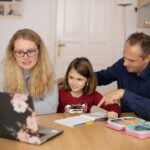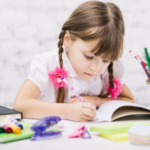21 June 2022
We all want to see our children as confident individuals, who will be able to face tricky situations on their own and will be prepared for adult life. Children’s confidence starts being shaped from an early age so parents need to think early on about what they can do to help their children’s confidence grow. To help our children more confident, we need time, patience, and a lot of practice.
What Are Confidence-Building Activities?
There are many ways of helping your children become more confident. One of them is encouraging your children to engage in confidence-building activities. Before I list the most interesting ones, let me tell you what these activities are. In short, confidence-building activities are fun activities, in which children will face small challenges and will have to work towards a small goal.
It is important to note that these activities should focus on children’s strengths rather than weaknesses. It is ok for children not to do well in some of these games and instead of berating their children for their struggles, parents should encourage them to look at things from a positive perspective.
Confidence-Building Activities
Let us have a look at some activities aimed at building confidence, which will be suitable for all types of schoolchildren. Schoolchildren students need self-confidence like nobody else as they need to learn how to have a good relationships with other students and build relationships with teachers.
Encourage your children to write a letter to themselves
Yes, it sounds a little strange but writing to oneself is a wonderful way for us to understand and accept ourselves. There are several ways of encouraging children to write to themselves.
Ask your children to write to their future selves. In their letter, children should write about what they are hoping to achieve and the goals they want to reach. After finishing their letters, they should give them to you. Then, at the end of the year, return the letters to your children and ask them to carefully read them. Then after they are finished, encourage them to reflect on their progress and what they have achieved.
If they did not reach all their goals or failed at a certain goal, celebrate what they have managed to do and encourage them to keep going. Also, encourage them to think about what could have gone wrong and what could have been the reason for their failure. Again, ask them to reflect and think about what they can learn from their experience so that in the future they are able to achieve all their goals.
Do an activity that will help your children manage their negative self-talk
Give your children a piece of paper and ask them to divide it into three columns. In the middle column, they should write negative things that they tell themselves whenever they face a demanding situation. For example: “I simply cannot do this”,” I am not good enough,” “It is simply unachievable,” and “I am not cool enough.”
Then in the left column ask students to make a list of situations that cause them to have such thoughts. Such situations may include getting a bad grade, having a lot of homework, or having an argument with their classmates.
In the right column, students should write a list of positive statements, which they can use instead of their negative self-talk. For the sake of simplicity, students can just reverse their statements from the middle column. For instance, they can write: “I can do this,” “I am good and capable,” “I can achieve this” and so on.
This activity will help children be conscious of the negative self-talk that they may have in challenging situations. It will also help them recognize negative thoughts and, most importantly, reframe them and replace them with words and phrases, which will empower them.
Ask your child to keep a goals journal
When we set goals, we are more likely to achieve them. So, each quarter of the school year, encourage your children to write down one potentially achievable goal in their diary. Ask them to describe the obstacles they may encounter on the way to achieving them and a plan to surmount them.
Each week ask students to look at the page where they wrote down their goal and reflect on whether they have done something this week to move closer to it. If not, ask them to think if they need to make some changes to their plan. If they have, celebrate their progress, and give them a high-five.
“I am activity”
Give your children a big white sheet of paper. Then ask them to paste a photo of themselves in the middle. Give them colored pencils and ask them to brainstorm social roles that they think define them. For example, children can write “I am a son/daughter,” “I am a student,” “I am a friend,” “I am a football player” and so on. Then ask them to write positive things about each of these roles. For example – “I am a son”: “I respect my parents,” “I help them around the house,” and “I love my parents.”
By writing down their social roles and thinking about them, children reflect on their identity and help themselves recognize that they have many positive qualities (which may not have been obvious to them before).
If this activity is done in class, then after each student has completed their task, they can share their work with their partners and read their roles and the associated positive qualities aloud. For a better result, teachers can encourage other students to add more positive traits to other students’ lists.
Encourage your students to keep a gratitude journal
There is extensive Bootcamp research demonstrating that those people who practice gratitude are likely to have better self-esteem and confidence. By practicing gratitude, children are learning how to recognize positive things around them and in themselves too.
How often should children make entries in their gratitude journals? Well, it does not really matter. They can write something in their journals once a week or a month. If your children are struggling to express gratitude in the written form, just ask them to write three or five things that they felt grateful for during the week or the month, respectively.
Have your children teach you how to do an activity
For instance, if your child loves drawing, singing, or playing a musical instrument, approach them and ask them to show how they do it. Ask them questions and encourage them to give more advice to you.
There is simple research showing that when we teach others something we remember what we have learned and apply this knowledge in real life. When we share our knowledge were feeling that we are responsible for other people’s learning. We inevitably become confident as a result.
Five positive self-affirmations each week
This is another way of addressing children’s self-talk and building their confidence. This activity can be extremely important for those kids who have a severe lack of confidence. The truth is that the more such positive statements your children write, the better they will feel about themselves. These self-affirmations will eventually turn into a steady train of thought, which will eventually replace your children’s negative thoughts.
Encourage your child to practice school presentations at home with you
Presenting in front of a packed class can be a nerve-wracking experience for your children, so why not help them rehearse it at home? Gather your family members and explain to them that the presentation is necessary and that everyone will benefit from listening to it.
Then ask your child (the one who has an assigned school presentation) to present. Each time they go over their speech, their confidence will improve. Sympathetic listeners from the family will also help them in that. After the presentation, you can offer your child some constructive feedback. Talk to your child about the importance of body language and tone of voice.
Try karaoke for kids
Singing and dancing can be an excellent way for your children not only to enjoy themselves but also to build up their confidence. Laughing and having an enjoyable time will help your children forget about their confidence issues and will get them into the habit of being outgoing and sociable.
Russ Gadzhiev obtained his Ph.D. in history and politics from the University of Melbourne. He also holds a master’s degree in International Relations from Moscow State University of International Relations, a top-ranking diplomatic school. Russ is a strong education professional with a history of working in the higher education sector of Australia who effectively communicates with learners from diverse cultural backgrounds. His background includes teaching, mentoring, writing, curriculum development, research, information management, and public speaking. He is fluent in Russian, English, Spanish, and Portuguese.








































